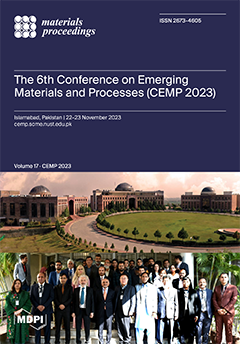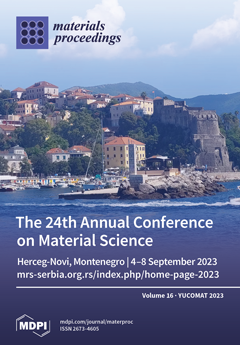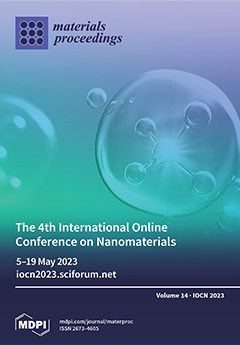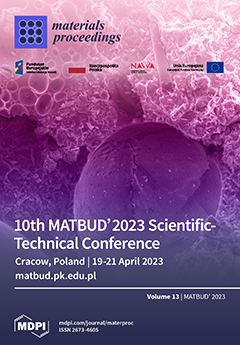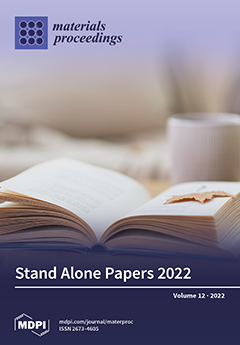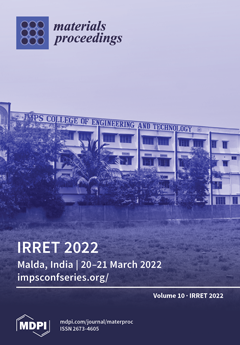Journal Description
Materials Proceedings
Materials Proceedings
is an open access journal dedicated to publishing findings resulting from conferences, workshops, and similar events, in all areas of material sciences. The conference organizers and proceedings editors are responsible for managing the peer-review process and selecting papers for conference proceedings.
Latest Articles
Mining and Mineral Exploration Projects within the Natura 2000 Area: Case Studies from Northern Finland
Mater. Proc. 2023, 15(1), 86; https://doi.org/10.3390/materproc2023015086 (registering DOI) - 24 Apr 2024
Abstract
►
Show Figures
The Rompas–Prajapat (Au-Co) and Sakatti (Ni-Cu-PGE) mineral deposits are among the only important discoveries of the last few decades in Finland. Both are partially located in Natura 2000 areas, which are among the most sensitive land use contexts in which mining and mineral
[...] Read more.
The Rompas–Prajapat (Au-Co) and Sakatti (Ni-Cu-PGE) mineral deposits are among the only important discoveries of the last few decades in Finland. Both are partially located in Natura 2000 areas, which are among the most sensitive land use contexts in which mining and mineral disputes have emerged in Finland. Consequently, the project holders apply low-impact mineral exploration technologies and practice active stakeholder engagement and communication. In fact, projects seem to be mostly favored by local populations. However, because of their association with protected areas (and uranium in the case of Rompas), projects are opposed by non-governmental organizations, as well as by reindeer herders in the case of Sakatti. Project holders perform feasibility studies and environmental impact assessments. Mining licenses are applied under a new Finnish mining act and the European Union’s Raw Materials acts.
Full article
Open AccessProceeding Paper
Fabrication of 2-D Nanosheets of NbSe2 via Liquid Phase Exfoliation and Their Morphological, Structural, and Optical Characterization
by
Ayesha Jamshed, Maryam Basit, Saqib Ali, Sumbal Hakeem, Muhammad Arman Liaqat, Fatima Jamshed, Rahim Jan and Sofia Javed
Mater. Proc. 2024, 17(1), 27; https://doi.org/10.3390/materproc2024017027 - 24 Apr 2024
Abstract
The present work is on the synthesis and investigation of the structural, optical, and optoelectrical properties of NbSe2 as an efficient material for energy conversion applications. The liquid phase exfoliation method was employed for the synthesis of 2D nanosheets from the bulk
[...] Read more.
The present work is on the synthesis and investigation of the structural, optical, and optoelectrical properties of NbSe2 as an efficient material for energy conversion applications. The liquid phase exfoliation method was employed for the synthesis of 2D nanosheets from the bulk NbSe2 at different exfoliation levels. SEM was used to confirm the physical dimensions of the nanosheets, while XRD was used to verify the structural retention of hexagonal nanosheets. The results demonstrate that high-quality, single-crystalline NbSe2 nanosheets with a size of ≈1 μm in the lateral dimension and ≈6–12 nm thick were obtained. The 2D nanosheets will be further explored for energy storage and conversion applications.
Full article
(This article belongs to the Proceedings of CEMP 2023)
►▼
Show Figures
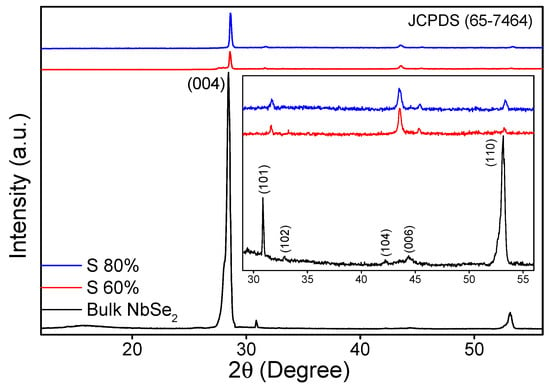
Figure 1
Open AccessProceeding Paper
Alternative Resources of Rare Earth Elements in Pakistan
by
Muhammad Daniel Saeed Pirzada
Mater. Proc. 2024, 17(1), 26; https://doi.org/10.3390/materproc2024017026 - 23 Apr 2024
Abstract
Rare earth elements (REEs) have emerged as strategic elements. Due to their unique electronic and magnetic properties, REEs have extensive applications in modern-day technologies. Two aspects make the supply chain of REEs very critical: first, more than ~85% of the global rare earth
[...] Read more.
Rare earth elements (REEs) have emerged as strategic elements. Due to their unique electronic and magnetic properties, REEs have extensive applications in modern-day technologies. Two aspects make the supply chain of REEs very critical: first, more than ~85% of the global rare earth elements are processed by China alone; second, presently, hardly any substitute materials exist for these elements. The supply chain of these elements is vulnerable because of the Chinese monopoly on rare earth resources. These circumstances drove researchers to explore alternative resources for these elements. This article reviews the prospective alternative resources of REEs. Based on the available resources and technical experience, a road map has also been suggested.
Full article
(This article belongs to the Proceedings of CEMP 2023)
Open AccessProceeding Paper
Lignin-Derived Materials for Sustainable Development of Ionic Thermoelectric Supercapacitors
by
Muhammad Muddasar, Mario Culebras and Maurice N. Collins
Mater. Proc. 2024, 17(1), 25; https://doi.org/10.3390/materproc2024017025 - 23 Apr 2024
Abstract
Lignin, a paper and pulp industry waste product, has attracted significant attention in recent years as a promising sustainable material for high-end energy applications. Herein, we examine lignin as a potential material for ionic thermoelectric hydrogels and carbon-based materials. Optimized lignin-derived hydrogels demonstrate
[...] Read more.
Lignin, a paper and pulp industry waste product, has attracted significant attention in recent years as a promising sustainable material for high-end energy applications. Herein, we examine lignin as a potential material for ionic thermoelectric hydrogels and carbon-based materials. Optimized lignin-derived hydrogels demonstrate a remarkable Seebeck coefficient of 3.63 mV/K when subjected to an axial temperature gradient. Furthermore, synthesized lignin-based porous carbon materials exhibit exceptional performance as supercapacitor electrodes, with a superior specific capacitance of 56.3 F/g at 0.5 A/g. Lignin-based hydrogels and porous carbon electrodes offer a promising path towards the development of lignin-derived ionic thermoelectric supercapacitors.
Full article
(This article belongs to the Proceedings of CEMP 2023)
►▼
Show Figures
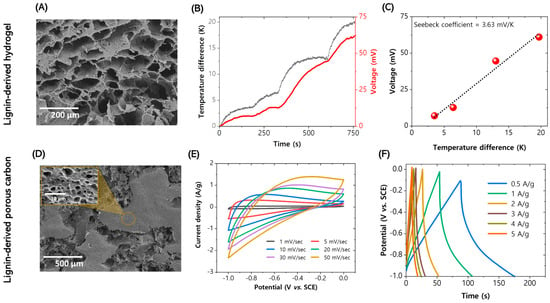
Figure 1
Open AccessProceeding Paper
Photovoltaic Performance of TiO2 Nanotubes Anodized under Different Voltages
by
Tayyaba Ghani, Mazhar Mehmood, Hira Kanwal, Muniba Yaseen Naz and Shazia Bashir
Mater. Proc. 2024, 17(1), 24; https://doi.org/10.3390/materproc2024017024 - 22 Apr 2024
Abstract
The present study was conducted to develop highly ordered facile TiO2 nanotubes (TiNTs) at two different applied voltages using two-step electrochemical anodization for the application in dye-sensitized solar cells (DSSCs). The nanotube fabrication is carried out in an aqueous electrolyte containing ethylene
[...] Read more.
The present study was conducted to develop highly ordered facile TiO2 nanotubes (TiNTs) at two different applied voltages using two-step electrochemical anodization for the application in dye-sensitized solar cells (DSSCs). The nanotube fabrication is carried out in an aqueous electrolyte containing ethylene glycol and ammonium fluoride at 40 V and 60 V fixed applied potentials. Nanotubes synthesized at 40 V are comparatively uniform and smoother, whereas a rough top surface is observed at 60 V. The photovoltaic efficiency achieved for the device based on TiNTs prepared at 40 V is 0.84% which is higher than the efficiency achieved for the 60 V device. This work highlights the importance of ordered nanotubes for efficient devices.
Full article
(This article belongs to the Proceedings of CEMP 2023)
►▼
Show Figures

Figure 1
Open AccessProceeding Paper
Fuel Composites Development Using Cow Dung and Agricultural Biomass
by
Muhammad Tufail Anwar, Nehar Ullah, Saifullah Khalid, Naeem Ahmad and Muhammad Shahzeb Khan
Mater. Proc. 2024, 17(1), 23; https://doi.org/10.3390/materproc2024017023 - 22 Apr 2024
Abstract
A sustainable alternative to fossil fuels, cow dung is a renewable energy source that might considerably lower carbon emissions. By modifying its characteristics, such as its gross calorific value (GCV), it could be utilized as a flexible and effective fuel for both industrial
[...] Read more.
A sustainable alternative to fossil fuels, cow dung is a renewable energy source that might considerably lower carbon emissions. By modifying its characteristics, such as its gross calorific value (GCV), it could be utilized as a flexible and effective fuel for both industrial and domestic use. To create a fuel composite with a higher heating value, this research examines the heating values and proximate analysis of local cow dung as well as the effects of blending it with agricultural waste. To provide the best heating value, the technique comprises infusing prepared agricultural biomass blends and cow dung at particular ratios. The composite’s quality was enhanced by increasing GCV from 3066 Kcal/kg to 3600 Kcal/kg, increasing volatile matter content, i.e., from 60% to 68%, as well as lowering the ash content of the resultant pellet from 19% to 11%, on average.
Full article
(This article belongs to the Proceedings of CEMP 2023)
►▼
Show Figures
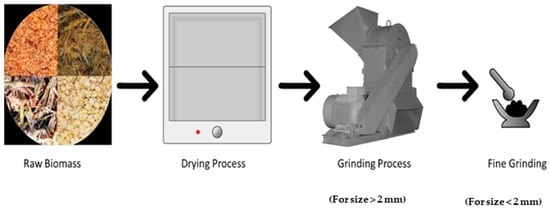
Figure 1
Open AccessProceeding Paper
Enhancing Fresh Water Production in Solar Parabolic Dish Desalination System
by
Abdul Wahab, Waqas Javid, Hamza Ahmed, Abdullah Sheikh, Muhammad Shahbaz and Shahid Iqbal
Mater. Proc. 2024, 17(1), 22; https://doi.org/10.3390/materproc2024017022 - 19 Apr 2024
Abstract
This study presents a solar-powered parabolic dish desalination system with a solar tracking system and conical receiver. It efficiently transforms solar radiation into heat and evaporates saltwater, producing fresh water. The system is sustainable and affordable, making it a viable solution for water
[...] Read more.
This study presents a solar-powered parabolic dish desalination system with a solar tracking system and conical receiver. It efficiently transforms solar radiation into heat and evaporates saltwater, producing fresh water. The system is sustainable and affordable, making it a viable solution for water desalination in areas with limited access to fresh water. It achieves a high conversion rate from saltwater to fresh water, while consuming minimal energy. The results indicate that the system effectively utilizes solar energy, exhibiting high efficiency levels ranging from 78.56% to 82.77%, with an average efficiency of 80.79%. This system offers an effective solution to meet the growing demand for fresh water in water-scarce regions.
Full article
(This article belongs to the Proceedings of CEMP 2023)
►▼
Show Figures
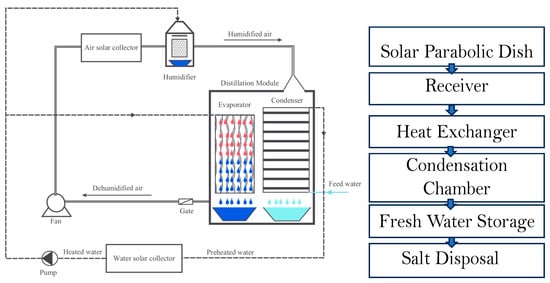
Figure 1
Open AccessProceeding Paper
Performance Analysis of Advanced Nuclear Power Plant with Variation of Sea Water Temperature
by
Muhammad Umair Tariq, Rashid Ali, Syed Muhammad Haris and Sajjad Ali
Mater. Proc. 2024, 17(1), 21; https://doi.org/10.3390/materproc2024017021 - 19 Apr 2024
Abstract
Nuclear power plays a significant role in fulfilling the energy needs of Pakistan and its share in the total energy mix has increased from 4.7% to 8.8% in the past seven years. As per the Pakistan energy outlook report (2021–2030), this share is
[...] Read more.
Nuclear power plays a significant role in fulfilling the energy needs of Pakistan and its share in the total energy mix has increased from 4.7% to 8.8% in the past seven years. As per the Pakistan energy outlook report (2021–2030), this share is hypothesized to increase to 10.82% by the year 2030, which will alleviate the energy shortage problem and, at same time, reduce carbon emissions. Like all thermal power plants, it is also necessary for nuclear plants to operate at optimum efficiency. This study is based on the thermodynamic analysis of the conventional side of an advanced HPR-1000 (PWR) nuclear power plant. In this paper, a comparison of indigenously developed model results is made, with vendor-provided sea water temperatures and power curves for year-long sea water temperature variation. Firstly, a computational model is developed using Engineering Equation Solver (EES) software to evaluate the performance of the secondary side of the plant and is validated based on the designer-provided heat balance analysis for full power mode. Then, the condenser heat balance is performed for different cooling medium inlet temperatures and terminal temperature differences to study the relationship of condenser performance, thermal efficiency, and output power. Initial results reveal that sea water temperature varies at the condenser inlet from 5 to 35 °C, the power output of the unit decreases by 54 MW, and the thermodynamic efficiency drops by 1.79%. Thus, this paper highlights the impact of sea water temperature on plant performance and the need to devise more effective techniques to approach the plant’s optimum efficiency.
Full article
(This article belongs to the Proceedings of CEMP 2023)
►▼
Show Figures
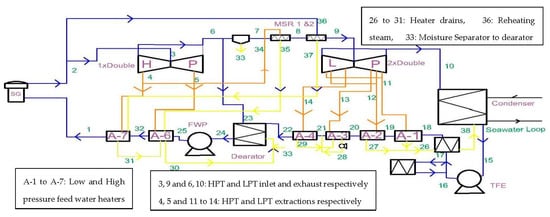
Figure 1
Open AccessProceeding Paper
Nanofiltration (NF) and Reverse-Osmosis (RO) Membranes for Aqueous Ammonium Nitrate Salt Rejection: Experimental Studies
by
Zulfiqar Ali and Tahir Maqsood Qaisrani
Mater. Proc. 2024, 17(1), 20; https://doi.org/10.3390/materproc2024017020 - 19 Apr 2024
Abstract
Herein, two commercially available spiral-wound nanofiltration (NF) and reverse-osmosis (RO) membrane elements were tested for aqueous ammonium nitrate salt separation. The effect of feed concentration and salt rejection as a function of transmembrane pressure were evaluated. NF and RO membranes exhibited 60% and
[...] Read more.
Herein, two commercially available spiral-wound nanofiltration (NF) and reverse-osmosis (RO) membrane elements were tested for aqueous ammonium nitrate salt separation. The effect of feed concentration and salt rejection as a function of transmembrane pressure were evaluated. NF and RO membranes exhibited 60% and 92% ammonium nitrate salt rejection, respectively, upon the initial feed concentration of 0.1 wt% at a seven-bar operating pressure. High ammonium nitrate salt rejection by the RO membrane was owing to its relatively small pore size compared to the NF membrane. It was found experimentally that the commercially available RO and NF membrane elements can be used for ammonium nitrate salt rejections from industrial effluents at ambient conditions.
Full article
(This article belongs to the Proceedings of CEMP 2023)
►▼
Show Figures
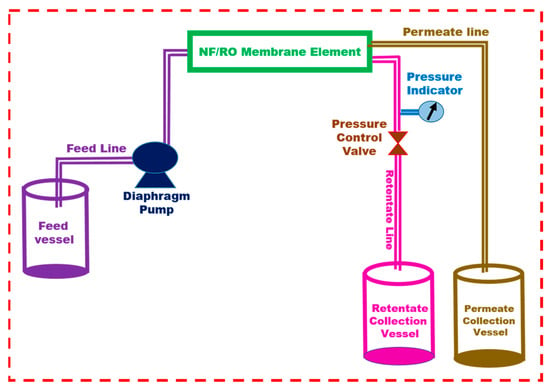
Figure 1
Open AccessProceeding Paper
Effective Surface Washing of All Inorganic Perovskite Nanocrystals to Enhance Optoelectronic Properties
by
Saqib Ali, Maryam Basit, Muhammad Arman Liaquat, Muhammad Adnan, Aftab Akram and Sofia Javed
Mater. Proc. 2024, 17(1), 19; https://doi.org/10.3390/materproc2024017019 - 18 Apr 2024
Abstract
All inorganic perovskite colloidal nano crystals are an emerging class of optoelectronic materials. However, their colloidal and structural stability during isolation and washing are major hurdles for their commercial application. Their intrinsic chemical instability and optical stability are directly related to the bonding
[...] Read more.
All inorganic perovskite colloidal nano crystals are an emerging class of optoelectronic materials. However, their colloidal and structural stability during isolation and washing are major hurdles for their commercial application. Their intrinsic chemical instability and optical stability are directly related to the bonding nature of the nanocrystals’ surface and organic capping agents that passivate the surface of nanocrystals. We studied the surface ligand properties of CsPbBr3 prepared by the conventional hot injection method and their washing with varying polarity antisolvent. We observed changes in electrical and optical properties through experimental studies. The study was mainly done by optical and electronic measurements. We determined a facile nanocrystal washing protocol and observed a considerable improvement in the optoelectronic properties of the all-inorganic perovskite colloidal nanocrystals.
Full article
(This article belongs to the Proceedings of CEMP 2023)
►▼
Show Figures

Figure 1
Open AccessEditorial
Preface of the 6th Conference on Emerging Materials Processes
by
Sofia Javed, Waheed Miran, Erum Pervaiz and Iftikhar Ahmad
Mater. Proc. 2024, 17(1), 1; https://doi.org/10.3390/materproc2024017001 - 18 Apr 2024
Abstract
The 6th Conference on Emerging Materials and Processes (CEMP 2023) was held on 22–23 November 2023, at the School of Chemical and Materials Engineering (SCME), National University of Sciences and Technology (NUST), Islamabad, Pakistan “https://cemp [...]
Full article
(This article belongs to the Proceedings of CEMP 2023)
►▼
Show Figures

Figure 1
Open AccessProceeding Paper
A Novel Low-Cost Mechanism for Energy Generation through Footsteps
by
Syed Azfar Imam Zaidi, Shahid Iqbal, Fahad Hussain, Muhammad Hammad Ikram, Waqas Javid and Muhammad Mateen
Mater. Proc. 2024, 17(1), 18; https://doi.org/10.3390/materproc2024017018 - 15 Apr 2024
Abstract
Energy is the primary concern of the modern era and the requirement of energy is being increased day by day; energy resources are not sufficiently available for sustainable development. It is crucial to generate affordable and pollution-free sources of energy to meet this
[...] Read more.
Energy is the primary concern of the modern era and the requirement of energy is being increased day by day; energy resources are not sufficiently available for sustainable development. It is crucial to generate affordable and pollution-free sources of energy to meet this required demand. Walking is a common daily activity for humans; the kinetic energy from walking is converted into mechanical energy. Moreover, this energy is converted into electrical power using a rack-and-pinion mechanism which is simply a non-conventional method of producing electric current. In this research study, a simple and low-cost rack-and-pinion mechanism with a flywheel is introduced to enhance the performance and efficiency of energy conversion from kinetic energy to mechanical energy and subsequently into electrical energy. The results showed that the proposed footstep floor tile generated an average power of 3 watts for a 0.5 s duration with a peak load of 60 kg. The electrical energy produced per step was noted as 1.8 Joules. A percentage of 75% of the total potential energy theoretically accessible was transmitted by the energy-harvesting paver, and 50% of it was successfully converted into electricity. The generated energy is stored in a backup battery bank system and can be used to charge smart devices, providing a cost-effective and pollution-free solution.
Full article
(This article belongs to the Proceedings of CEMP 2023)
►▼
Show Figures
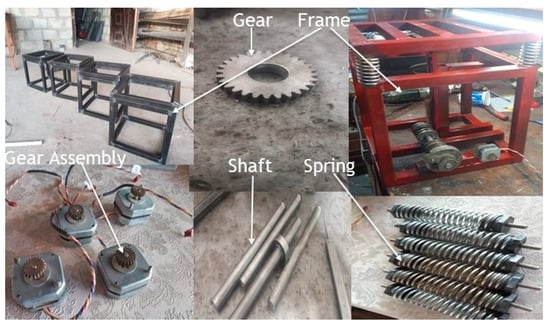
Figure 1
Open AccessProceeding Paper
Modeling Approach to Estimate Energy Consumption of Reverse Osmosis and forward Osmosis Membrane Separation Processes for Seawater Desalination
by
Yasir Hussain, Muhammad Irfan and Saeed Gul
Mater. Proc. 2024, 17(1), 17; https://doi.org/10.3390/materproc2024017017 - 12 Apr 2024
Abstract
Due to growing industrialization and population increase, water scarcity is becoming a major global concern. Desalination is often regarded as a potential solution to the worldwide water crisis; however, due to rising prices and energy usage, desalination has remained a research focus. Traditionally,
[...] Read more.
Due to growing industrialization and population increase, water scarcity is becoming a major global concern. Desalination is often regarded as a potential solution to the worldwide water crisis; however, due to rising prices and energy usage, desalination has remained a research focus. Traditionally, specific energy consumption (SEC) kWh/m3 for seawater desalination has been calculated using a hybrid approach that ignores membrane design attributes and operational parameters. The current study constructed a mathematical framework based on well-established theory to quantify and compare the energy consumption of pressure-driven and osmotic-driven membrane separation processes by incorporating the necessary membrane design and operational parameters into the model framework. The model results were compared to the literature data and found to be in good agreement. The findings of this study show a non-linear relationship between the membrane flowrate factor and the energy needs of reverse osmosis RO, with the effect being more obvious at low values of Kf < 50 L/h.bar, where Kf is equal to the product of membrane permeability and membrane area. The results also showed that the lowest SEC was obtained at 60–65% recovery, and, from model testing, the energy consumption was 3.65 kWh/m3 and 3.88 kWh/m3 for the RO and FO–RO processes, respectively. Additionally, the hybrid process demands more membrane area, which further raises the cost of desalination. The mathematical framework developed in this work will act as a prediction design tool for membrane plant designers to check and compare the feasibility of these processes before experimental work to save money and time.
Full article
(This article belongs to the Proceedings of CEMP 2023)
►▼
Show Figures
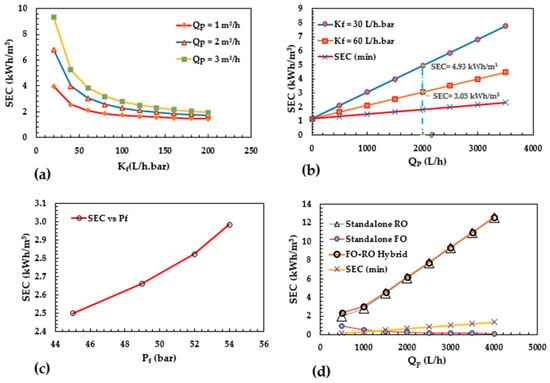
Figure 1
Open AccessProceeding Paper
Parametric Optimization of High-Dielectric Organic Thin-Film Solar Cells
by
Muhammad Raheel Khan and Bożena Jarząbek
Mater. Proc. 2024, 17(1), 16; https://doi.org/10.3390/materproc2024017016 - 12 Apr 2024
Abstract
Organic solar cells (OSCs) have the potential to generate electricity under sunlight at a low cost. In this study, the influence of active layer thickness, defect density, temperature and the presence of reflective coating is studied for the structure ITO/PTAA/PBDB-T: ITIC-OE/PDINO/Ag, by applying
[...] Read more.
Organic solar cells (OSCs) have the potential to generate electricity under sunlight at a low cost. In this study, the influence of active layer thickness, defect density, temperature and the presence of reflective coating is studied for the structure ITO/PTAA/PBDB-T: ITIC-OE/PDINO/Ag, by applying PTAA as a hole transport layer (HTL), while the blend of PBDB-T: ITIC-OE is used as an active layer and PDINO is applied as electron transport layer (ETL), respectively. Solar capacitance simulator one-dimensional (SCAPS—1D) software is used to optimize different parameters, which affect the performance of OSCs. By introducing backside reflective coating, the efficiency increases by 2.5%. In the future, this study can be used for the power conversion efficiency (PCE) enhancement of OSCs.
Full article
(This article belongs to the Proceedings of CEMP 2023)
►▼
Show Figures
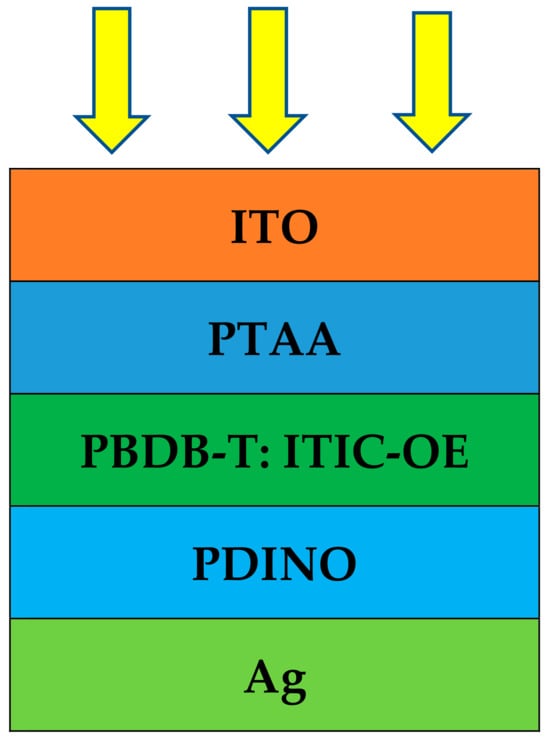
Figure 1
Open AccessProceeding Paper
Exergy Analysis of Methanol Production Plant from Hydrogenation of Carbon Dioxide
by
Muhammad Zulkefal, Asad Ayub and Hamza Sethi
Mater. Proc. 2024, 17(1), 15; https://doi.org/10.3390/materproc2024017015 - 12 Apr 2024
Abstract
Reducing greenhouse gas (GHG) emissions through carbon capture and conversion to fuel and other useful products is a focus of recent research. Among all fuels, CO2 to methanol stands out for its efficiency and promise. To make the CO2-to-methanol (CTM)
[...] Read more.
Reducing greenhouse gas (GHG) emissions through carbon capture and conversion to fuel and other useful products is a focus of recent research. Among all fuels, CO2 to methanol stands out for its efficiency and promise. To make the CO2-to-methanol (CTM) process sustainable and efficient, it needs to be analyzed with respect to its thermodynamic potential. Conventionally, energy analysis was used, but exergy analysis is an advanced tool used for this purpose. In this study, the Aspen Plus-based CTM model was developed, and its exergy analysis was carried out. Physical exergy data are taken from Aspen Plus V.11, while an interface between Aspen Plus and Excel was used to calculate the exergy destruction, exergy efficiency, and the improvement potential of the process. All three sections of the CTM model were compared and it was observed that the separation section has the highest exergy destruction of 37,225.89 KW with an exergy efficiency and exergetic improvement potential of 76.17% and 8870.75 KW, respectively.
Full article
(This article belongs to the Proceedings of CEMP 2023)
►▼
Show Figures

Figure 1
Open AccessProceeding Paper
Visible Absorption Spectra and In Vitro Cytotoxicity of Rhodamine-640 Perchlorate on Rhabdomyosarcoma Cancer Cell Line
by
Muniba Yaseen, Ahmat Khurshid, Tayyaba Ghani and Hafeez Ullah
Mater. Proc. 2024, 17(1), 14; https://doi.org/10.3390/materproc2024017014 - 11 Apr 2024
Abstract
Photosensitizers have been used for years to treat or diagnose several oncological diseases. In this research, we evaluate Rhodamine (Rh-640 perchlorate), a second-generation photosensitizer’s mediated preliminary photodynamic effects. To investigate these preliminary dose–response effects on the Rhabdomyosarcoma cancer cell line, the UV absorption
[...] Read more.
Photosensitizers have been used for years to treat or diagnose several oncological diseases. In this research, we evaluate Rhodamine (Rh-640 perchlorate), a second-generation photosensitizer’s mediated preliminary photodynamic effects. To investigate these preliminary dose–response effects on the Rhabdomyosarcoma cancer cell line, the UV absorption spectra, standard curve, and cytotoxic analysis of Rh-640 perchlorate are demonstrated. The absorption spectra suggest that longer wavelengths of light like yellow-red light are best used for light irradiation. Different concentrations are used to evaluate absorbance and cytotoxic response. The results suggest that Rh-640 perchlorate may be used for the selective destruction of cancer cells without imposing any toxicity on normal cells in the dark. This research finding also suggests that its efficiency may also be evaluated on other cancer cell lines.
Full article
(This article belongs to the Proceedings of CEMP 2023)
►▼
Show Figures
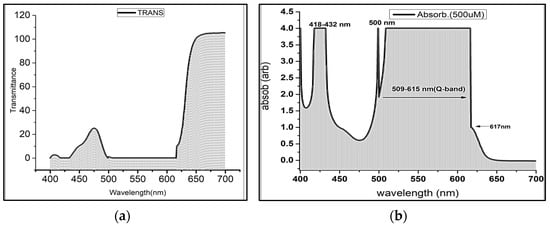
Figure 1
Open AccessProceeding Paper
Exergy Analysis of an Alkaline Water Electrolysis System
by
Hamza Sethi, Muhammad Zulkefal and Asad Ayub
Mater. Proc. 2024, 17(1), 13; https://doi.org/10.3390/materproc2024017013 - 11 Apr 2024
Abstract
Life on Earth is being affected daily by the enormous amounts of greenhouse gas emissions, due to the utilization of fossil fuels to produce energy for almost everything. Many researchers have been working for the development of new clean and sustainable energy sources
[...] Read more.
Life on Earth is being affected daily by the enormous amounts of greenhouse gas emissions, due to the utilization of fossil fuels to produce energy for almost everything. Many researchers have been working for the development of new clean and sustainable energy sources such as solar and wind energies. Hydrogen, being a clean fuel having very high calorific value, can be used as a storage medium for these renewable energy sources and can be used efficiently in fuel cells, as well as in combustion engines. This research is focused on the investigation of hydrogen production through the electrolysis of water. An Aspen Plus-based model for the electrolysis process has been designed and validated and its exergy analysis has been conducted. Also, the improvement potential of all the equipment has been reported.
Full article
(This article belongs to the Proceedings of CEMP 2023)
►▼
Show Figures
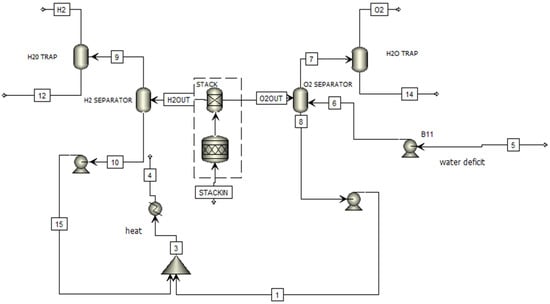
Figure 1
Open AccessProceeding Paper
Cattaneo-Christov Heat Flux Model Effect on Magnetized Maxwell Nanofluid Flow over a Stretching Surface
by
Muhammad Jameel, Zahir Shah, Muhammad Salim Khan and Nekmat Ullah
Mater. Proc. 2024, 17(1), 12; https://doi.org/10.3390/materproc2024017012 - 11 Apr 2024
Abstract
This study investigates the flow of a magnetohydrodynamic (MHD) Maxwell fluid over a stretching sheet using a Darcy-Forchheimer (DF) model. We employ numerical analysis with a copper (Cu) nanofluid suspended in water, considering Cattaneo–Christov heat flow, viscous dissipation, and joule heating. Nonlinear ordinary
[...] Read more.
This study investigates the flow of a magnetohydrodynamic (MHD) Maxwell fluid over a stretching sheet using a Darcy-Forchheimer (DF) model. We employ numerical analysis with a copper (Cu) nanofluid suspended in water, considering Cattaneo–Christov heat flow, viscous dissipation, and joule heating. Nonlinear ordinary differential equations (ODEs) are solved using the bvp4c method in Matlab and we examine the normalized shear stress, temperature profile, and heat flux rate. Our findings reveal insights for practical applications, showing how parameters such as the relaxation Prandtl number, magnetic parameter, Eckert number parameter, and radiation parameter impact system behaviour.
Full article
(This article belongs to the Proceedings of CEMP 2023)
►▼
Show Figures
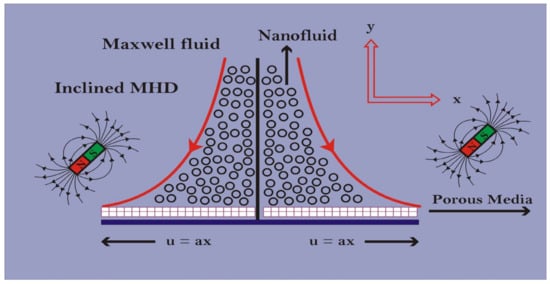
Figure 1
Open AccessProceeding Paper
A Clean and Efficient Energy Solution for Climate Change Mitigation and Energy Crises in Pakistan: The Atmospheric Vortex Engine
by
Muhammad Arslan, Muhammad Ahsan Imran, Muhammad Tariq, Kanwar Haziq Afzal and Muhammad Waseem
Mater. Proc. 2024, 17(1), 11; https://doi.org/10.3390/materproc2024017011 - 11 Apr 2024
Abstract
Heat carried upward by atmospheric convection produces mechanical energy. An atmospheric vortex engine (AVE) uses a synthetic tornado-like vortex to capture mechanical energy from upward heat convection. The vortex is created by tangentially introducing warm or humid air into a circular wall base.
[...] Read more.
Heat carried upward by atmospheric convection produces mechanical energy. An atmospheric vortex engine (AVE) uses a synthetic tornado-like vortex to capture mechanical energy from upward heat convection. The vortex is created by tangentially introducing warm or humid air into a circular wall base. Heat sources include solar energy, warm sea water, warm, humid air, and industrial waste. Earth’s natural surface collects heat, eliminating the need for solar collectors. The AVE uses the same thermodynamic principles as the solar chimney, but it uses centrifugal force in a vortex instead of a chimney and the earth’s surface instead of a collector. Turbogenerators nearby generate mechanical energy. Since the AVE uses less fuel to generate the same amount of electricity, it could reduce global warming. An AVE increases thermal power plant efficiency by lowering its cold-source temperature from the base of the troposphere to the tropopause. The AVE process could reduce global warming by lifting heat above greenhouse gases to radiate toward space. Since Pakistan is most affected by climate change and has many energy crises, this study aims to change engineers’ mindsets from inefficient conventional energy sources to more efficient non-conventional, cleaner energy sources.
Full article
(This article belongs to the Proceedings of CEMP 2023)
►▼
Show Figures
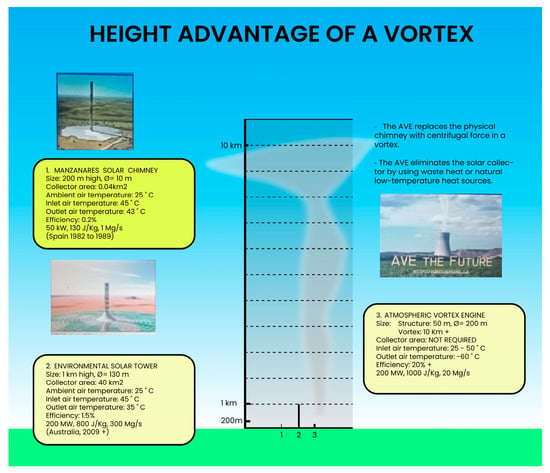
Figure 1
Open AccessProceeding Paper
Artificial-Intelligence-Assisted Investigation of Quality and Yield of Cumene Production
by
Asad Ayub, Muhammad Zulkefal and Hamza Sethi
Mater. Proc. 2024, 17(1), 10; https://doi.org/10.3390/materproc2024017010 - 10 Apr 2024
Abstract
Global demand for cumene is rising day by day due to its broad applications in the production of numerous types of polymers like nylon-6, epoxy resins, and polycarbonates. Efforts to enhance process design and operation efficiency are ongoing. However, addressing process uncertainties remains
[...] Read more.
Global demand for cumene is rising day by day due to its broad applications in the production of numerous types of polymers like nylon-6, epoxy resins, and polycarbonates. Efforts to enhance process design and operation efficiency are ongoing. However, addressing process uncertainties remains a significant challenge for stable process industry operations. Artificial neural networks (ANNs) have proven to be powerful tools for modelling and predicting complex chemical processes, offering substantial potential for improving the quality and quantity of cumene production. In the present study, a data-based model was used for the prediction of the molar flow and mole fraction of cumene in the final product stream. A steady-state Aspen plus model was set to a dynamic mode by deliberately introducing ±10% variability in process conditions. This dynamic model served as the foundation for generating a comprehensive dataset. Two ANN models were developed using the dataset for the prediction of the molar flow and mole fraction of cumene. During the rigorous testing phase, the models demonstrated outstanding performance, as evidenced by their correlation coefficient values of 0.99216 and 0.99412 for the molar flow and mole fraction of cumene, respectively. These high correlation coefficients provide compelling evidence of the models’ robust and precise predictive capabilities, highlighting their potential for real-world application. This study paves the way for Al integration in the process industry, making a significant step toward embracing industry 4.0.
Full article
(This article belongs to the Proceedings of CEMP 2023)
►▼
Show Figures
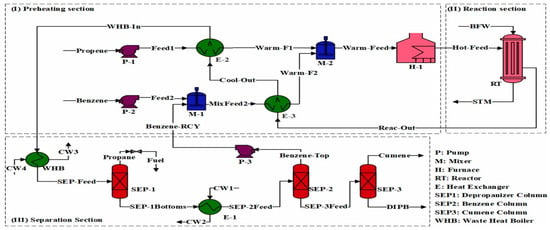
Figure 1
Highly Accessed Articles
Latest Books
E-Mail Alert
News
Topics


